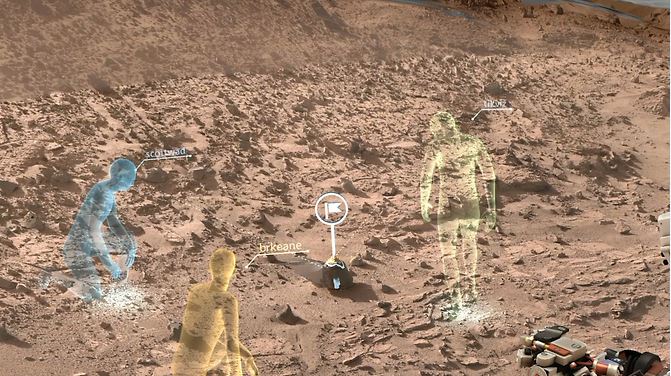Microsoft and NASA have got together to develop a software that will enable scientists to work virtually on Mars. Called OnSight, the software is used in wearable technology called Microsoft HoloLens.
OnSight, which was developed by NASA’s JPL (Jet Propulsion Laboratory) in California, will allow scientists to plan and carry out scientific operations on the red planet with the Mars Curiosity rover.
Program executive for the Mars Science Laboratory mission at NASA Headquarters in Washington, Dave Lavery, said:
“OnSight gives our rover scientists the ability to walk around and explore Mars right from their offices. It fundamentally changes our perception of Mars, and how we understand the Mars environment surrounding the rover.”
The software will use real rover data and extend the Curiosity mission’s current planning tools by creating a three-D simulation of the Martian environment where scientists from all over the world can meet.

OnSight will utilize holographic computing to overlay visual data and information from the Mars Curiosity Rover into the user’s field of view. (Image: NASA)
Within the simulation, scientists will be able to examine the rover’s worksite from a first-person perspective, as if they were there themselves, plan new activities and preview their results first-hand.
Jeff Norris, JPL’s OnSight project manager:
“We believe OnSight will enhance the ways in which we explore Mars and share that journey of exploration with the world.”
To date, scientists have had to examine Mars imagery on a computer screen, and extrapolate from what they can see. Even 3-D stereo monitor views lack the natural sense of depth that human vision employs to process spatial relationships. The new technology will give them that.
According to NASA “The OnSight system uses holographic computing to overlay visual information and rover data into the user’s field of view. Holographic computing blends a view of the physical world with computer-generated imagery to create a hybrid of real and virtual.”
In order to view this holographic environment, Curiosity mission team members wear a Microsoft HoloLens device which surrounds them with images from the rover’s Martian field site. They can roam about the rocky surface or bend down and examine rocky outcrops from various angles.

The HoloLens wearable device. According to Microsoft “Holograms are the next evolution in computing.” (Image: Microsoft)
The device provides access to engineers and scientists seeking to interact with Mars in a more natural, human way.
Mr. Norris said:
“Previously, our Mars explorers have been stuck on one side of a computer screen. This tool gives them the ability to explore the rover’s surroundings much as an Earth geologist would do field work here on our planet.”
The OnSight tool will also help scientists plan rover’s operations. For example, they can program activities for many of rover’s scientific instruments by looking at a target and selecting menu commands by using gestures.
NASA says it plans to start testing OnSight in Curiosity mission operations later in 2015. It may be used for the Mars 2020 rover mission operations, as well as others.
Video – Microsoft HoloLens & NASA OnSight

